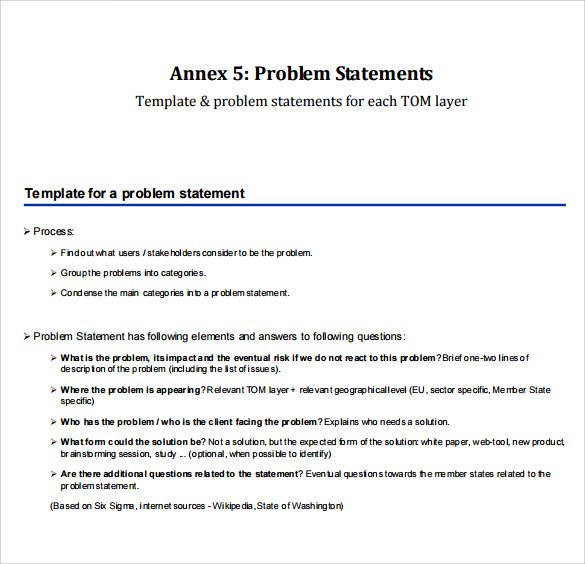Nursing assignments involve a lot of meticulous research and writing. Moreover, a problem statement helps you simplify things to a large extent. However, formatting a good research problem statement is no child’s play.
Statement of purpose and problem statement are vital aspects of your paper. They give the reader a brief idea about the scope and nature of your topic. You can refer to this guide by Nova South-eastern University for more details.
Here is a step by step approach to developing a problem statement for you to follow:
1} Problem statement VS statement of purpose
Statement of purpose state the intent of the paper. The problem statement highlights the core issues you discuss in your research. The problem statement deals with the who, what, where, why, when of your research (but more on that later)
Write the problem statement after the abstract, but before the introduction. The statement of purpose soon follows the problem statement. Your paper then expands on the research methodology and central themes of the subject.
Step 1: Understand your topic
Firstly, you need to understand the nursing topic before you begin the problem. What is your paper about? What are your key points of discussion? What do you plan to achieve from this research? These are some core questions you need clear answers for.
The problem statement is different from a hypothesis, which is a logical construct to prove or disprove your research. In nursing assignments, the problem statement states the crux of the issue.
Note that you can only use third-person pronouns in the problem statement. Also, this section must be in the past tense. Discuss the nature, purpose, and other details of the paper in a nutshell.
Step 2: Listing the details
Collect all the details you want to include in the problem statement. This is a short section that shouldn’t extend more than 7-10 lines max. You can start with an introductory line.
The problem statement is both informative and persuasive. It effectively sets the background for your introduction. It also gives you the space to reinstate the main points of your paper.
Step 3: In-depth analysis
The problem statement though short is very comprehensive. Include some details about your paper. The main purpose of any research is to shed more light in their area of study. State the sector, organization, and core issues of your paper.
For instance, you can add details about your department and compare it to the other factions of the hospital. Begin with a statement like “this paper examines….” It sets the context of your research.
To write a good nursing research problem statement
Step 4: Summarize your points.
The problem statement and purpose of research pitches the research subject. It is one of the first things the reader comes across. Keep the language professional, academic, but intriguing.
With a problem statement, you highlight the research topic, methodology and how to accomplish it. Ensure that your problem statement is readable and relevant.
Step 5: Clarity and conciseness
The problem statement educates the reader about the research. At the same time, it also discusses the practical application of the research in everyday life. The problem statement furthers the argument in your nursing paper.
The trick is to get straight to the point. Don’t beat around the bush, begin straightway with the core issues of your research. If your paper talks about the shortage of nursing equipment, then start with a stat or report on the same.
2} The three elements of a problem statement
Every problem statement has three main elements– the vision, the issue, and the research methodology. These three parts together constitute the foundation of your research. Your main paper further discusses these factors by using charts and stats.
Every paper must have a unique vision, purpose, and approach. It gives the reader an insight into your understanding of the topic. Plus, you also get the space to elaborate on your arguments and express them.
a. Vision
A research paper is incomplete without a holistic vision. A nursing assignment is not just a collection of references and findings of other people. You must also add your two cents to the subject.
With the vision, you briefly explain the things you want to accomplish with your research. Students have the choice to either take a localized approach or write a paper that deals with a universal issue.
b. Issue
This is where you discuss the details of your research. What are the main areas you plan to focus on? You can talk about the books, journals and scholars cited in the paper. Students can even discuss how the research would benefit a certain aspect of the nursing industry.
Consider the issue as the main body of your problem statement. It is a section where you get to set the premise and points of your research. Structure your arguments in a way that gives the reader an idea about your paper.
c. Method
Professors also look into the research methodology used for completing the paper. Nursing research papers can either be descriptive, critical, or statistical. The problem statement must be instead of this format.
You can also add extra footnotes and annotations towards the end of your statement. Also, don’t forget to add a citation for all the quotes and figures included. For nursing papers, I recommend APA or Harvard style referencing. Check out the university guide or citation generators for quick and accurate citations.
To write a good nursing research problem statement
3} How to write a nursing research problem statement?
Writing a nursing research problem statement is easier said than done. There are five main questions or focus areas every problem statement covers. These questions define the content, research tools and essential accomplishment of the paper.
So, without further ado, let us discuss these five elements and what to include in them.
a. Who
This is the section that determines your reader base. Who are you writing this paper for? Frequently, your nursing research contributes to a specific department, group, or organization. You might have to tweak your language a bit according to your audience base. Academic writing is quite different from a professional one.
b. What
This section covers the boundaries of your research. It gives you a general format to your paper. What would your paper include? What is the significant impact of the issue? Here, you talk about the contribution of your research.
The problem statement lays down the problem areas of your topic and how to resolve it. Towards the conclusion, you can also discuss the scope of your research and its effect on the healthcare industry.
c. When
The “when” part of the problem statement sets your research in a specific time frame. It determines the relevance and credibility of your study. You can also discuss the short-term and long -term impacts of your proposal throughout your paper.
Addressing the “when” part of the question gives your paper more credibility. Which medical practice do you refer to? What is the context and background of your research? These are a few aspects you must cover here.
d. Where
Every nation has a set of medical standards, techniques, and practices. And most students prefer keeping their study restricted to their country or state.
The nursing regulations and eligibility also vary from place to place. You can discuss theories which are universal to all healthcare sectors. But that’s a very exhaustive process which requires in-depth study and analysis.
e. Why
Saving the best for last, the “why” is vital to your research. Here, you talk about the reason why your paper is essential for the nursing community. This section also considers the impact your research has on the treatment and diagnosis of an ailment.
I suggest my students devote maximum space and time to this section. This is the crux of your problem statement that you expand upon in the main body of your paper.
4} What is the problem statement?
A problem statement comes at the very beginning of your paper, right after the abstract. It is a section that outlines the critical aspects of your research. It is a clear-cut description of the issue and the methods used to resolve it. Read through some samples and templates online for a better idea.
With the problem statement, you clarify a lot of aspects of your research to the reader. It also simplifies your paper. A cursory reading of the report would tell the reader everything about your assignment.
Students who are not familiar with academic writing might find this a bit complicated. Don’t worry, though, this is where I come to help. You can consult your professors and peers for more.
5} The bottom line
The problem statement presents the main questions discussed in the paper. Anyone can understand the central themes and nature of the research after reading the problem statement. I hope this guide was useful and would help you ace your assignment. Good luck!
To write a good nursing research problem statement






 WhatsApp Us
WhatsApp Us